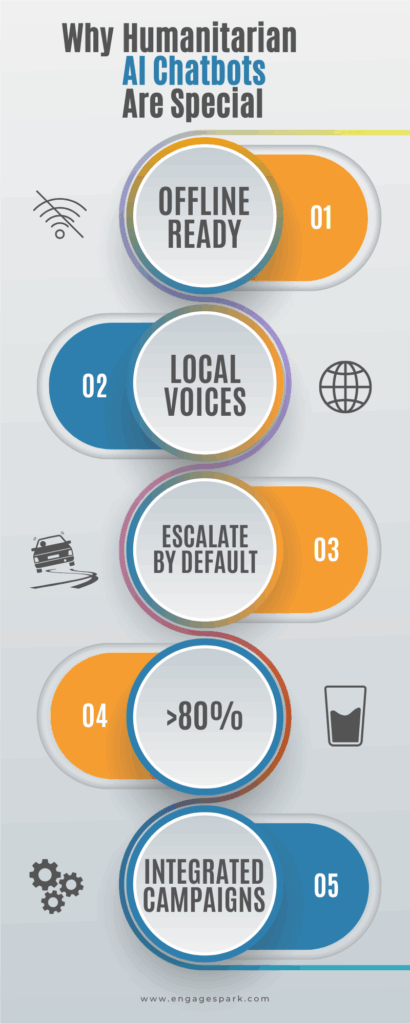Why can’t NGOs use a run-of-the-mill AI chatbot? Are requirements for humanitarian organizations really so different that a customer support chatbot built for companies doesn’t do the trick? Well, yes—and we’ll give you five reasons why. This blog post is part of the “Chatbots for LMICs” series, Find the other parts in the series introduction.
Now, don’t get us wrong: your customer service chatbot can do wonders for donor relations—donors who are online, who engage with your website—and that’s great. But when it comes to the people your organization serves, those in low- or middle-income countries (LMICs), you’ll often find that chatbots built for customer support fall short.
Here are the key differences that matter when building AI chatbots for humanitarian work, with an infographic as overview:
1. Online-Only vs Offline-Ready
Most commercial chatbots assume users are online with stable internet, a smartphone, and a browser. Well, that’s not a great assumption to make in LMICs, is it. People often have weak connections, limited data, or aren’t online at all.
A good platform must adapt to this and provide options. That’s why for example we support SMS and WhatsApp for our chatbots, which maximizes the people we can reach with our chatbots.
2. Global Languages vs Local Voices
Commercial bots typically focus on major languages like English or Spanish. But NGOs often need to reach people in local languages—and support code-switching, when users mix languages naturally in one message.
Humanitarian chatbots can’t just focus on major markets, and must therefore work to support low-resource languages.
3. Close Fast vs Escalate Safely
In the commercial world, bots are optimized to end conversations quickly—ideally without human involvement. While recently, many bots have made it easier to talk to a human, this is more about managing frustrations rather than safety.
But for humanitarian programs, safety and care are much more central topics. If someone’s lifelihood is being affected, hallucinations and half-answers aren’t great. If someone indicates they’re in danger, that isn’t an aberration to be ignored.
Where a regular customer support bot might push to “resolve” the conversation, a humanitarian chatbot may well chose to err on the side of caution and escalate the chat to a human.
4. 80% Coverage vs Full Inclusion
Sales teams are fine if a bot works well for the digitally fluent majority. But humanitarian programs aim to be inclusive—reaching people who respond slowly, have low literacy, or use local dialects.
That means offering multiple input types and means of communication—SMS, buttons, audio clips—and a forgiving flow design.
5. Passive Bots vs Integration and Outreach
Most commercial bots wait for users to start the conversation. But NGOs often need to reach out first—to educate, survey, or follow up.
With engageSPARK, chatbots are integrated in our existing campaigns—supporting proactive messaging with proper opt-in, scheduled follow-ups, and logic for retries and reminders across multiple channels.
The Bottom Line
AI chatbots are powerful—but only if they fit the context. Most platforms are built for customer service, not community impact.
At engageSPARK, we build AI tools specifically for NGOs and social impact programs in LMICs—tools that prioritize inclusion, flexibility, and human safety. This focus allows us to learn from one project to the next and thus help build better humanitarian SMS and WhatsApp chatbots.

